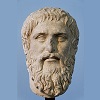7.9: Byzantium - Crisis and Recovery
- Page ID
- 11409
Although the Byzantine Empire was a remnant of the Roman state, by the eighth century it was much weaker than the Roman Empire under Augustus or even than the Eastern Empire under Justinian. After their conquest of Egypt, the forces of the caliphate had built a navy and used it to sail up and lay siege to Constantinople itself in two sieges lasting from 674 to 678 and from 717 to 718. On land, to the northwest, the Empire faced the threat of the Bulgars, Slavs, and Avars. The Avars, a nomadic people, in particular demanded that the Byzantine state pay them a hefty tribute to avoid raids. At the very moment that the Empire was in greatest need of military strength, it was a poorer empire than it had ever been.
The solution was a reorganization of the military. Instead of having a military that was paid out of a central treasury, the emperors divided the Empire up into regions called themes. Each theme would then equip and pay soldiers, using its agricultural resources to do so. Themes in coastal regions were responsible for the navy. In many ways, the theme was similar to the way that other states would raise soldiers in the absence of a strong bureaucratic apparatus. One might liken it to what we call feudalism in Zhou China, Heian Japan, and later Medieval Europe.
The greatest crisis faced by the Byzantine Empire in these years of crisis was the so-called Iconoclast Controversy. From the fourth and fifth centuries, Christians living in the Eastern Mediterranean region had used icons to aid in worship. An icon is a highly stylized painting of Christ, the Virgin Mary (his mother), or the saints. Often icons appeared in churches, with the ceiling painted with a picture of Christ or with an emblem of Christ above the entrance of a church.
Other Christians opposed this use of images. In the Old Testament (the term Christians use to refer to the Hebrew Bible), the Ten Commandments forbid the making of “graven images” and using them in worship (Exodus 20:4-5). Certain Christians at the time believed that to make an image even of Jesus Christ and his mother violated that commandment, arguing that to paint such pictures and use them in worship was idolatry, that is, worshiping something other than God. Muslims leveled similar critiques at the Christian use of icons, claiming that it showed Christians had fallen from the correct worship of God into idolatry.
.png?revision=1)
Emperor Leo III (r. 717 – 41) accepted these arguments; consequently, in his reign he began to order icons removed (or painted over) first from churches and then from monasteries as well as other places of public display. His successors took further action, ordering the destruction of icons. These acts by Leo led to nearly a century of controversy over whether the use of icons in worship was permissible to Christians. The iconophiles argued that to use a picture of Christ and the saints in worship was in line with the Christian scriptures so long as the worshiper worshiped God with the icon as a guide, while the icolonoclasts proclaimed that any use of images in Christian worship was forbidden.
In general, monks and civilian elites were iconophiles, while iconoclasm was popular with the army. In Rome, which was slipping out from under the jurisdiction of the Byzantine emperors, the popes strongly rejected iconoclasm. Some historians have argued that Leo and his successors attacked icon worship for reasons other than religious convictions alone, including the fact that monks who venerated icons had built up their own power base; more importantly, in confiscating the wealth of iconophile monasteries, the emperor would be able to better fund his armed forces.
The iconophile empress Irene, ruling on behalf of her infant son Constantine V (r. 780 – 797), convoked a new church council to bring an end to the controversy. At the 787 Second Council of Nicaea, the Church decreed that icons could be used in worship. Final resolution of the Iconoclast Controversy, however, would have to wait until 843, when the empress Theodora at last overturned iconoclastic policies for good upon the death of her husband, the emperor Theophilus (r. 829 – 843). From this point forward, historians usually refer to the Greek-speaking churches of the eastern Mediterranean and those churches following those same patterns of worship as Eastern Orthodox. 3
Although the iconoclast emperors had made enemies in the Church, they were often effective military commanders, and they managed to stabilize the frontiers with Arabs, Slavs, and Bulgars. In spite of the fact that the Byzantine armies of the eighth century would have some successes against Arabs and Slavs, it was during the eighth century that Byzantium increasingly lost control of Italy. While a Byzantine exarch, or governor, in Ravenna (in northeastern Italy) would rule the city of Rome, even these Italian territories were gradually lost. Ravenna fell to the Lombards in 751; the duke of Naples ceased to acknowledge the authority of the emperor in Constantinople in the 750s; and the popes in Rome, long the de facto governors of the city, became effectively independent from Byzantium in the 770s. The popes in particular would increasingly look to another power to secure their city: the Franks.
3 Modern historians use this label for convenience. At the time, both Churches in the Greek-speaking eastern Mediterranean and those following the pope would have said that they were part of the Catholic Church (the word catholic comes from a Greek word for “universal”). The churches in the eastern Mediterranean and Eastern Europe were coming to differ enough in terms of practice, worship, and thought that we can refer to them as distinct from the Catholic Church of Western Europe.


